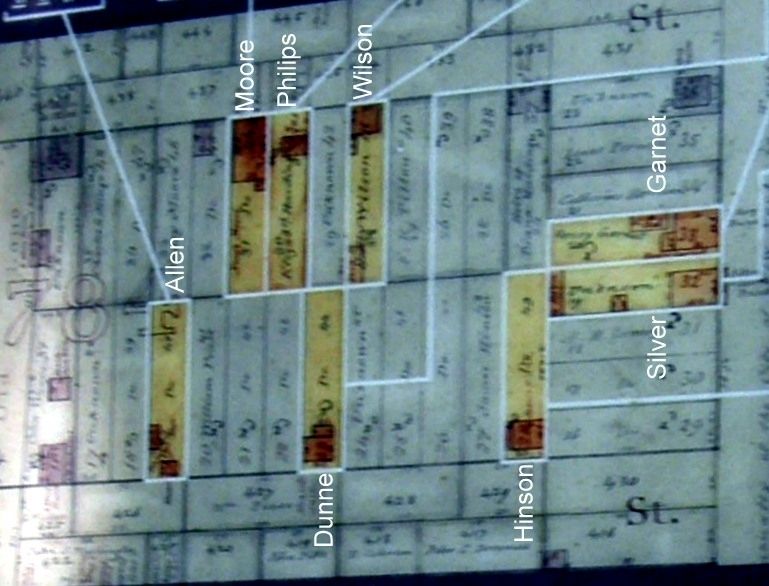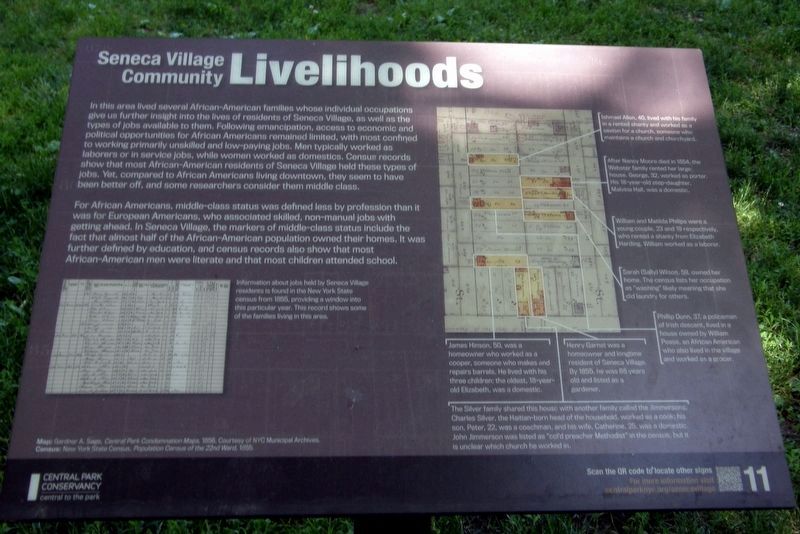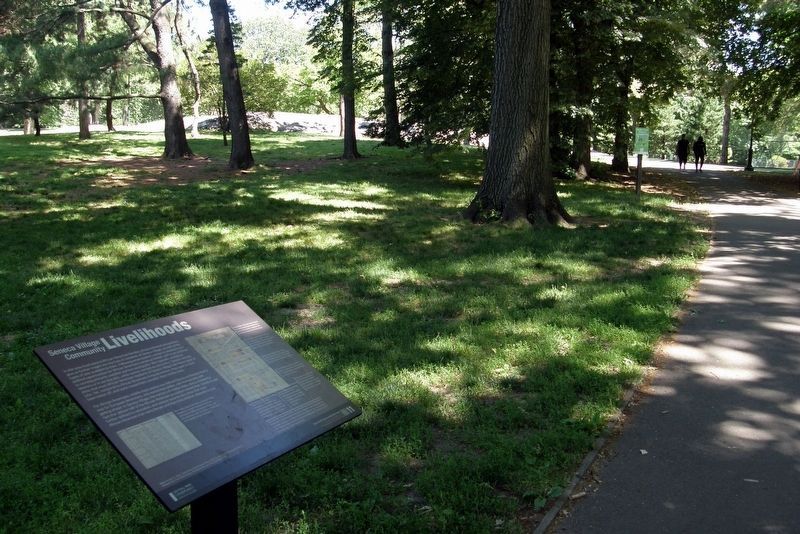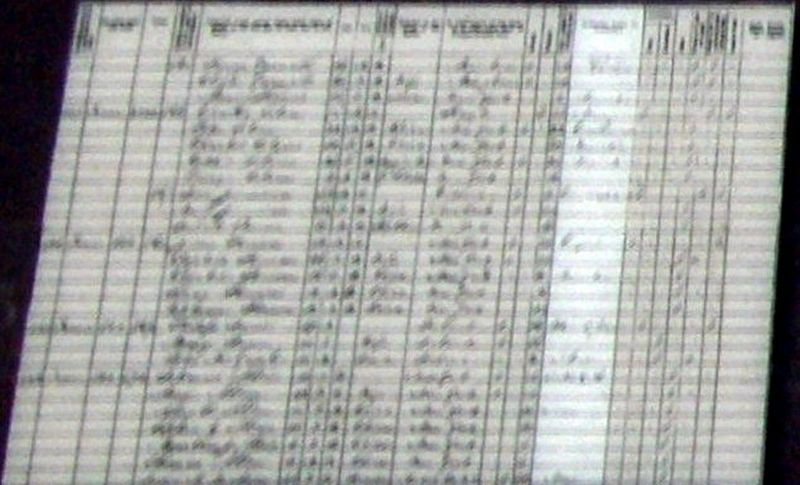Central Park West Historic District in Manhattan in New York County, New York — The American Northeast (Mid-Atlantic)
Livelihoods
Seneca Village Community
In this area lived several African-American families whose individual occupations give use further insight into the lives of residents of Seneca Village, as well as the types of jobs available to them. Following emancipation, access to economic and political opportunities for African-Americans remained limited, with most confined to working primarily unskilled and low-paying jobs. Men typically worked as laborers or in service jobs, while women worked as domestics. Census records show that most African-American residents of Seneca village held these types of jobs. Yet, compared to African Americans living downtown, they seem to have been better off, and some researchers consider them middle class.
For African Americans, middle-class status was defined less by profession than it was for European Americans, who considered skilled, non-manual jobs with getting ahead. In Seneca Village, the markers of middle-class status include the fact that almost half of the African-American population owned their homes. It was further defined by education, and census records also show that most African-American men were literate and that most children attended school.
Erected 2020 by Central Park Conservancy.
Topics. This historical marker is listed in these topic lists: African Americans • Parks & Recreational Areas • Settlements & Settlers.
Location. 40° 46.959′ N, 73° 58.063′ W. Marker is in Manhattan, New York, in New York County. It is in the Central Park West Historic District. Marker can be reached from West 83rd Street east of Central Park West. Touch for map. Marker is at or near this postal address: Central Park, New York NY 10024, United States of America. Touch for directions.
Other nearby markers. At least 8 other markers are within walking distance of this marker. Discover Seneca Village (within shouting distance of this marker); Geology (about 300 feet away, measured in a direct line); Reservoir Keepers (about 500 feet away); AME Zion Church (about 500 feet away); Housing (about 500 feet away); Lanes, Lots and Streets (about 500 feet away); African Union Church (about 500 feet away); Gardens (about 500 feet away). Touch for a list and map of all markers in Manhattan.
Also see . . .
1. Seneca Village. Wikipedia entry (Submitted on May 2, 2021, by Larry Gertner of New York, New York.)
2. Seneca Village Site. Central Park Conservancy website entry:
Links to several related sub-topics (Submitted on May 2, 2021, by Larry Gertner of New York, New York.)
3. Seneca Village, New York City. National Park Service entry
(Submitted on May 2, 2021, by Larry Gertner of New York, New York.)

Photographed By Larry Gertner, June 17, 2020
4. Inset (rotated 90 degrees)
Ishmael Allen, 40, lived with his family in a rented shanty and worked as a sexton for a church, someone who maintains a church and churchyard.
After Nancy Moore died in 1854, the Webster family rented her large house. George, 32, worked as a porter. His 18-year-old step-daughter, Malvina Hall, was a domestic.
William and Matilda Philips were a young couple who rented a shanty from Elizabeth Harding. William worked as a laborer.
Sarah (Sally) Wilson, 59, owned her home. The census lists her occupation as “washing” likely meaning that she did laundry for others.
Phillip Dunn, 37, a policeman of Irish decent, liv4ed in a house owned by William Pease, an African American who also lived in the village and worked as a grocer. Henry Garnet was a homeowner and longtime resident of Seneca Village. By 1855, he was 88 years old and listed as a gardener.
James Hilson. 50, was a homeowner who worked as a cooper, someone who makes and repairs barrels. He lived with his three children: the oldest, 18-year-old Elizabeth, was a domestic.
The Silver family shared this house with another family called the Jimmersons. Charles Silver, the Haitian-born head of the household, worked as a cook; his son, peter, was a coachman, and his wife, Catherine, 25, was a domestic. John Jimmerson was listed as “cold preacher Methodist” in the census, but it is unclear which church he worked for.
After Nancy Moore died in 1854, the Webster family rented her large house. George, 32, worked as a porter. His 18-year-old step-daughter, Malvina Hall, was a domestic.
William and Matilda Philips were a young couple who rented a shanty from Elizabeth Harding. William worked as a laborer.
Sarah (Sally) Wilson, 59, owned her home. The census lists her occupation as “washing” likely meaning that she did laundry for others.
Phillip Dunn, 37, a policeman of Irish decent, liv4ed in a house owned by William Pease, an African American who also lived in the village and worked as a grocer. Henry Garnet was a homeowner and longtime resident of Seneca Village. By 1855, he was 88 years old and listed as a gardener.
James Hilson. 50, was a homeowner who worked as a cooper, someone who makes and repairs barrels. He lived with his three children: the oldest, 18-year-old Elizabeth, was a domestic.
The Silver family shared this house with another family called the Jimmersons. Charles Silver, the Haitian-born head of the household, worked as a cook; his son, peter, was a coachman, and his wife, Catherine, 25, was a domestic. John Jimmerson was listed as “cold preacher Methodist” in the census, but it is unclear which church he worked for.
Credits. This page was last revised on January 31, 2023. It was originally submitted on May 2, 2021, by Larry Gertner of New York, New York. This page has been viewed 137 times since then and 20 times this year. Photos: 1, 2, 3, 4. submitted on May 2, 2021, by Larry Gertner of New York, New York.


